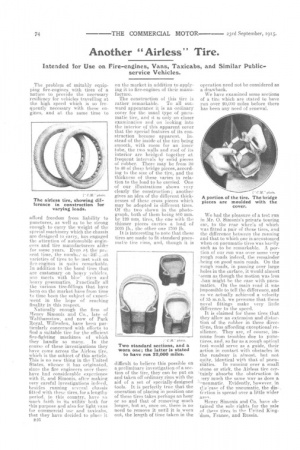Another " Airless ' Tire.
Page 14

If you've noticed an error in this article please click here to report it so we can fix it.
Intended for Use on Fire-engines, Vans, Taxicabs, and Similar Publicservice Vehicles.
The problem of suitably equipping fire-engines with tires of a nature to provide the necessary resiliency for vehicles travelling at the high speed which is so frequently necessary with these engines, and at the same time to
afford freedom from liability to punctures, as well as to be strong enough to carry the weight of the special machinery which the chassis are designed to carry, has engaged the attention of automobile engineers and tire manufacturers alike for sonic years. Even .st the pre7 sent time, the nurnbi:,:ir oi,
varieties of tires to bemet with on fife-engines is Quits remarkable. In addition to the band tires that are customary on heavy vehicles, one meets with Moe' tires and hea,vy pneumatics. Practically all the various tire-fillings that have been on the market have from time te;) time been the subject of exneri?Tient in the hope of reaching finality in this respect. Naturally enough the, firm of Henry Simonis and Co., late of Walthamstow, and now of Park Royal, Willesden, have been particularly concerned with efforts to find a suitable tire for the efficient fire-fighting machines. of which they handle so many. In the course of these investigations they have come across the Airless tire, which is the subject of this article. This is no new thing in the United States, whence ithas originated, since the fire engineers over there have had considerable experience with it, and Simonis, after making very careful investigations indeed, besides running several chassis fitted with these tires, for &lengthy period, in this country, have so much faith in its utility both for this purpose and also for light vans for commercial use and taxicabs, that they have decided to plac:-. it D1.6 on the market in addition to applying it to fire-engines of their manufacture.
The construction of this tire is
rather remarkable. To all outward appearance it is an ordinary cover for the usual type of pneumatic tire, and it is only on closer examination and on looking into the interior of this apparent cover that the special features of its construction become apparent. Instead of the inside of the tire being smooth, with room for an inner tube, the two walls and roof of its interior are bridged together at frequent intervals by solid pieces of rubber. There may be from 30 to 40 of these bridge pieces, accordmg to the size of the tire, and the thickness of these varies in relation to the load to be carried. One of our illustrations shows very clearly the construction ; another gives an idea of the different thicknesses of these cross pieces which may be adopted in different tires. Of the two shown in the photograph, both of them being S80 mm. by 120 mm, tires, the one with the thinner pieces carries a load of 1000 lb., the other one 1700 lb.
It is interesting to note that these tires are made to fit standard pnenmatze tirerims, arid, though it is
difficult to believe this possible on a preliminary investigation of a section of the tire, they can be put on and taken off ordinary rims with the aid of a set of specially-designed tools. It is perfectly true that the operation of placing in position one of these tires takes perhaps an hour or so and that of removing much longer, but as, once on, there is no need to remove it until it is worn out, the length of time taken in the operation need not be considered as a drawback.
We have examined sonic sections of a tire which are stated to have run over 20,000 miles before there has been any need of renewal.
We had the pleasure of a test run in Mr. 0. Simonis's private touring car, to the rear wheels of which wa-s fitted a pair of these tires, and the difference between the running and that to which one is accustomed when on pneumatic tires was hardly such as to be remarkable. A portion of our run was over some very rough roads indeed, the remainder eheing on good main roads. On the rough roads, in passing over large holes in the surface, it would almost 'seem as though the motion was less ..-han might be the case with pneumatics. On the main road it was impossible to tell the difference, and aswe actually achieved a velocity of 35 m.p.h. we presume that these novel fittings make very little difference to the speed.
It is claimed for these tires that they allow an extension and distortion of the rubber in three direcdims, thus affording exceptional resilience. They are, of course, immune from troubles due to punctUres, and, so far as a rough optical test would serve as a guide, their action in contact with obstacles in the roadway is almost, but not quite, identical with that of pneu m'atics. In running over a small stone or stick, the Airless tire vex'tainly absorbs the obstruction in rery much the same way as does a i
-'-neumatic. Evidently, however, n tl:e 'case of the Pneumatic, the dis-.. i'.ertion is spread over a little wider ares,
Henry Simonis and Co. have obtained the sole rights for the sale of three tires in the United Kingdom, France, and Russia.




















